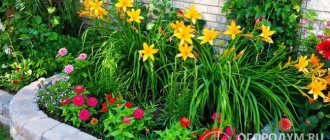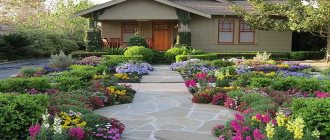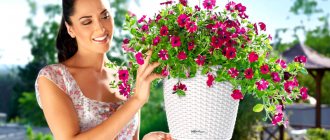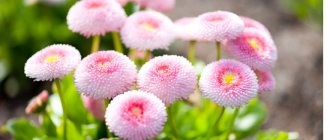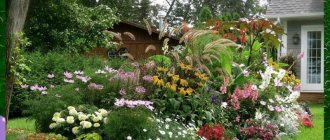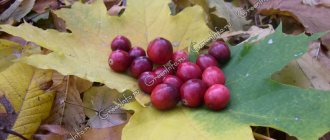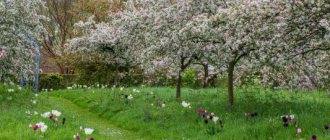Hanging plants are ornamental plants that have a long flexible stem and look beautiful in hanging pots. The stem of ampelous plants, as a rule, is not able to support itself; it needs to either rest on something or hang down. It is this property that makes hanging plants for the garden very popular among amateur gardeners. Such ornamental crops are mostly annuals in our conditions; they grow quickly, bloom almost all summer, and in a short period of time can transform the area adjacent to the house and individual corners of the garden into places of amazing beauty, inviting to relax among the splendor of the colors of nature.
The garden around the house was created using hanging plants - they are placed around the perimeter, suspended on the veranda. Their luxurious flowering can completely change the appearance of the site
Kinds
Ampelous plants for the garden, which can be planted in hanging pots, surprise with their diversity. The most common of them are:
- Petunia is the queen of ampelous flowers. Besides warmth and sun, she doesn’t really need anything else. Although an annual, it is very loved by gardeners;
- ampelous fuchsia is very spectacular, its flowers are small but bright;
- Surfinia is often called petunia; its flowers are similar, but smaller. Shoots can reach up to 1 m;
- Begonia is a shade-tolerant flower that does not tolerate sun and heat. It looks very beautiful in a flower pot, the greenery is at the top of the pot, and the inflorescences are cascading down;
Barrel with petunia
- ampelous geraniums are planted with several bushes of different colors in one pot. Multi-colored hats with long shoots delight the eye all summer;
- nasturtium is bright and colorful. The climbing type is suitable for hanging pots; upright bushes can decorate a flowerpot;
- Dichondra is called a silver waterfall due to the beautiful tint of its green leaves. The plant practically does not bloom, its advantage lies in its beautiful greenery, hanging down one and a half meters;
- lobelia is a bright bush with densely dotted small leaves and flowers. It is often planted only for the season, although it is perennial.
General care rules
By following a few care rules, you will create a comfortable living environment for your green pets.
- When planning to grow an ampelous plant in an apartment in a hanging pot, think about where you will mount it: to the ceiling or to the wall? Choose a strong mount, because it will need to support the plant, the container, and the weight of the pot after watering. Ceiling hooks attached with chains to pots have worked well.
- Most of this type of plant loves light, but grows poorly in dark places.
- It is more convenient to water with a watering can with an extended spout. This should be done regularly, but in moderation, to prevent the roots from rotting. If your flower grows in a decorative pot, pour out excess water after each watering.
- You need to spray hanging plants regularly, at any time of the year. The air at the top is drier than at the bottom, so don't skimp on water.
- Ampels that grow slowly do not need anti-aging pruning. Those plants whose shoots grow quickly, become elongated and lose their decorative appeal must be pruned regularly (zebrina, impatiens and pelargoniums).
- It is better to install the support either when the ampel has just begun to grow, or during transplantation, so as not to cause injury to the fragile root system. Bamboo is optimal in this case - it is well camouflaged in dense foliage, and it looks harmonious with the plant.
It is difficult to imagine a cozy home without indoor flowers. Currently, there are many varieties of them, each of which pleases with its sophistication, originality of colors, versatility of shapes and aromas. Therefore, you can always choose one or more plants, combining them by color, size and shape to create a beautiful composition.
Classification
Flowering shrubs for the garden, perennial and unpretentious
Plants are divided into several types and have their own characteristics:
- depending on preferences for light, there are light-loving and shade-loving;
- blooming ones love sun, warmth and regular watering. Most of them are annual. Those flowers that grow all year round require additional lighting;
- deciduous ones can do well in the shade. They may require high-quality soil to maintain bright leaf color, succulent stripes or spots;
- succulents require conditions close to the desert: the soil must be well-permeable, absorb moisture, the air must be dry, and there must be plenty of lighting.
Impatiens
Hanging balsam (or impatiens) does well in both sun and partial shade. Its stems with fleshy leaves grow up to 50 cm in length.
The flowering of the plant begins in May and ends only at the end of autumn. To make it more abundant, you need to add complex fertilizer to the soil several times a season.
If you bring a pot of balsam into the house before the cold snap, you can preserve the culture until the next season.
Benefits of Plants
What are ampelous plants and ampelous annual flowers?
The mobility of the plant is one of its main advantages. Even during one season, the location of the pot can be changed: to cover some unfinished areas in the garden, to hide areas of construction and repairs during the celebration. Plants do not require special care; they do not need to be weeded or to fight weeds and open ground pests.
For your information! If the plot of land in the garden is small, but you want a flower bed, unpretentious hanging flowers for the garden are an excellent solution.
Flowerbed design option
Features of sunflower
Sunflower is a herbaceous plant or subshrub represented by annuals and perennials; the stem can be straight or creeping, its length varies from 0.1 to 0.3 meters. Opposite simple leaf blades can have a shape varying from linear-lanceolate to oval. The racemose inflorescence consists of flowers, usually yellow, but they can also be pink, white or orange. The fruit is a one-locular or three-locular capsule, inside of which there are seeds.
Sunflower
Blooming for more than one year
Yellow daisies are perennial flowers
Ampelous perennials make life much easier for the gardener, since they do not need to be sown every year. It is enough to provide them with certain wintering conditions. These include:
- Scaevola pleasant overwinters in a humid room at a temperature not exceeding 10 °C;
- dichondra overwinters with additional lighting and rare watering;
- bacopa will not bloom in winter, but if watered moderately, it will overwinter comfortably;
- Campanula equifolia is an ampelous perennial that blooms all summer. Tolerates winter together with indoor plants. Popularly called “bride and groom”;
- perennial lobelia will overwinter if it is covered and not allowed to get too cold;
- geranium can also overwinter in an apartment; with moderate watering and light, it blooms in winter.
Calibrachoa
This petunia-like plant impresses with the huge number of flowers on the bush. It’s not for nothing that people call it “a million bells.”
Calibrachoa is planted outside when the threat of frost returns has passed. The crop will not develop well in rainy weather and strong winds.
To ensure flowering does not stop, it is necessary to fertilize every week. To form new buds, you should regularly remove old inflorescences.
What to plant and how to choose hanging plants for your garden
Before planting garden hanging flowers, you need to take into account their preferences for light, soil, and watering. If you want to combine different species, you should plant those flowers with each other that require the same care; to do this, you should study their descriptions.
Note! Plants that are absolutely unpretentious to shade and sun are petunia, geranium, nasturtium, bidens. These flowers are resistant to direct sunlight, but can also grow in the shade.
It will be easier with hanging flower arrangements in the garden, since they can be moved if the plant begins to show its dissatisfaction with the excess or lack of sunlight.
Wall of hanging pots
Climbing plants for a balcony in the sun
Perhaps this is the smallest group for landing on loggias. It is necessary that the flowers not only withstand direct sunlight, continuously produce buds, but also grow quickly.
Sweet pea or china
There are more than 1000 varieties. The plant is widely used in vertical gardening and is valued for its pleasant aroma and abundant flowering. The flexible stems are decorated with light green pinnate leaves, at the top of which there are tendrils clinging to the support. Branches weakly.
The flowers are collected 3-7 pieces in a brush, asymmetrical, similar to a sail or moths. Buds appear from June-July until frost. Any color except yellow.
Sweet peas will not grow in a flat pot.
morning glory
A liana about 5 m long with heart-shaped leaves is often called a loach. The flowers look like a gramophone, have a long stem and a pleasant smell. They densely dot the shoots, open only in bright sun, and are closed in cloudy weather. Blue, violet, blue, pink, red buds appear at the beginning of summer, replacing each other, decorating southern balconies until frost.
Kobeya
One of the most beautiful flowers for a balcony on the sunny side is the climbing, fast-growing annual kobeya shrub. The liana is up to 6 m long and can cling to brickwork or other uneven surfaces. The leaves are beautiful, pinnate, with 3 large lobes.
The flowers are bell-shaped, with a wavy edge of the corolla, up to 8 cm in diameter, on long stalks. The buds are greenish-yellow, and when fully opened they become white, purple, or different shades of purple.
It is difficult to choose flowers for the sunny side - there are many of them, all are beautiful, most are easy to care for. Here it is important to observe the measure and make sure that the colors are combined and the smells do not mix.
Compositions from ampelous plants
In open soil, you can create a picture with the help of ampelous outdoor plants. Suitable creeping plants that cover the soil include:
- Monkey loosestrife is a perennial plant that grows quickly as the weather warms up, covering the flower bed. The leaves are round, the flowers are small yellow, they can climb up and decorate the wall with their greenery;
- Lesser periwinkle is also a perennial, which in the spring will decorate its lush green shoots with purple flowers;
- dichondra will cover the carpet with long shoots and decorate the flowerbed.
Note! Old things that can be given a second life are suitable for decorating the garden as pots and flowerpots. These could be old carts, barrels, baskets, shoes.
For a dacha, hanging plants can decorate not only the site, but also braid a fence, a gazebo, and small structures (shower, cellar, outbuildings).
Even just placing pots along the path will become a decoration and will lift the spirits of both guests and owners
For your information! The more care and attention is invested at the beginning of a flower’s growth, the brighter and longer it will delight its gardener.
Contrasting combinations
For mixed compositions, you can combine different flowers, or you can plant the same type of different flowers. Pelargonium, petunia, nasturtium, fuchsia, and verbena will be excellent neighbors. They feel great in the company of other plant species. When creating a composition, you can play with:
- in color, choosing contrasts: white petunia and red pelargonium, blue lobelia and yellow begonia, fuchsia and white bacopa;
- in tiers. You can decorate the wall in tiers with colored balls. In such single pots, petunia, bacopa, lobelia, bidens will bloom in a spherical manner;
- shape and height. For example, dichondra, whose lashes will hang down, fits perfectly next to petunia. Fuchsia flowers fall down, and nasturtium may appear in the center.
Tiers in one pot
Almost all types of hanging plants are suitable for creating hanging gardens; the main thing is to remember that the smaller the pot, the more often the plant requires watering. Easy-to-care, hanging flowers for the garden will lift your spirits until the coldest weather.
Ampelous flowers for the garden
In the garden at your dacha, flowers in hanging pots, on tall flowerpots and even in hedges will look very beautiful.
Additional Information! The name Ampel means “hanging flower vase” in German.
Ampelous flowers will decorate the garden and dacha
Types of hanging plants
Ampelous garden flowers are divided into three main types:
- The blooming ones are distinguished by lush and beautiful flowering: petunia, bacopa, fuchsia, pelargonium, lobelia, hoya, columnea, surfinia, nolana, etc.
- Decorative deciduous plants are distinguished by beautiful leaves that grow quickly and take on an interesting shape: ivy, chlorophytum, dichondra, cissus, tradescantia, etc.
- Succulents are low-growing plants with delicate watery leaves: groundsel, eryphyllum, rhipsalis, sedum, etc.
Magnificent compositions from ampels
Features of hanging plants and their classification
The most important feature of all ampels is a flexible, elastic stem. Ambulous street plants are conventionally divided into several varieties:
- Multi-rosette - cascading ampels that bloom very brightly and abundantly. Designed for hanging flower pots.
- Descending - plants with long shoots hanging down. They are grown in hanging pots or tall flowerpots. These pots can be attached to the wall of a gazebo or terrace.
- Creeping - low-growing plants that quickly grow in width and cover the lawn, flower bed, garden path and any other horizontal surface. These plants can be used to complement the composition and make a “rug”.
- Climbers are deciduous or flowering vines. They have long branches that grow quickly, clinging to support. Climbing plants decorate terraces, roofs, walls of houses or gazebos. They are used to grow hedges.
- Climbing is the name given to vines that can grow up an arch, wall, fence or any other support.
Surfinia
Benefits of hanging plants
Ampelous plants for the garden have many advantages over other types of flora. Landscape designers always include these flowers in their compositions.
Advantages:
- Wide variety of species and varieties.
- Flowering continues almost all year round.
- An ampelous plant can cover a defect in a building or garden.
- They make up magnificent flower arrangements - real works of art.
Due to their amazing beauty, hanging plants are very popular among amateur gardeners and professional decorators.
Lobelia
Planting sunflowers in open ground
What time to plant
Sunflower seedlings are planted in the second half of May or in the first days of June, but before that they must be hardened off. Procedures associated with hardening seedlings last approximately 1.5–2 weeks; for this, they are moved outside every day. The duration of such procedures is increased gradually, starting from several hours. At the very end, when the plants have already hardened, they will be able to stay in the fresh air around the clock. At first, to harden seedlings, you should choose a place well protected from wind, rain and drafts.
Landing rules
Growing sunflowers in your own garden is quite simple. To plant it, you should choose a well-lit open area, and the suitable soil should be alkaline or neutral, and it must contain fine crushed stone and sand. Such flowers can also be grown on loamy soil, but before planting it is dug up and dolomite flour is added.
Since the bushes of this plant can grow very strongly in a short period of time, the distance between the planting holes should be at least 0.3 meters. At the same time, their depth should be such that a peat pot with a plant can be placed in them. Before planting, the seedlings are well watered, and then they are placed in pre-prepared planting holes; all existing voids should be filled with soil, the surface of which is then compacted around the flower. Planted bushes need abundant watering.
Growing sunflower from seeds
Sowing seedlings
As a rule, sunflower seeds are sown directly into open soil. However, there are cases when it is recommended to grow it through seedlings, which are then transplanted into the garden. Sowing seeds for seedlings is carried out in the first days of March. For this, it is recommended to use peat cups or tablets; the fact is that the root system of such a plant interacts with special beneficial fungi, and during transplantation or picking, this fungal layer can be destroyed, as a result, the planted bushes can get sick and even die. In this regard, experts do not recommend that such a plant be subjected to picking, replanting, or propagation by dividing the bush.
2 or 3 seeds are sown in one container, and they are laid out on the surface of a loose and moistened substrate, covered with a thin layer of sand or vermiculite, and the containers are covered with glass or film and transferred to a place where there is bright but diffused light, and The air temperature ranges from 18 to 24 degrees. The first seedlings may appear either after 7 or 30 days. Immediately after this happens, the shelter is removed from the container, while the plants themselves are transferred to a cooler place (from 15 to 16 degrees). To improve the development and growth of seedlings, it needs to provide a difference between air temperatures during the day and night; it should be about 4–5 degrees. After the plants grow, they need to be thinned out; to do this, take scissors and cut off those seedlings that are the weakest at the surface level of the substrate in each container. As a result, only one of the most powerful and healthy seedlings should remain in each glass. It is very simple to care for the seedlings; you need to water them in a timely manner and systematically carefully loosen the surface of the substrate around the bushes.

